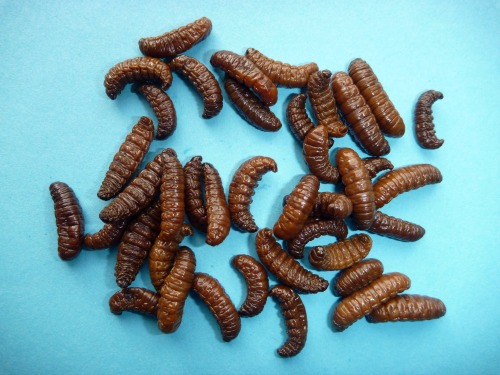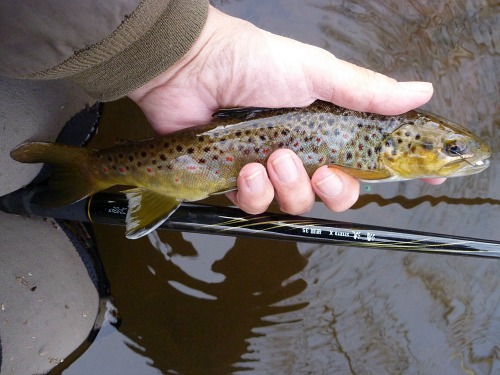Mummy Worms
Update: I no longer carry Mummy Worms, and would suggest purchasing them directly from Eurotackle.
I first learned of Mummy Worms from the taxidermist who makes Jackalope heads for Cabela's. Now I know that mummification and taxidermy aren't the same, at least not quite, but somehow it seems fitting.
And then there's the whole question "Are they real?" to which the only possible answer is "Which one, Jackalopes or Mummy Worms?" Jackalopes are clearly real, I mean, if you have a Jackalope head on your wall you can hang your hat on it (as long as it's a small hat - Jackalopes have small horns - antlers, really, but no one likes a know-it-all).
Mummy Worms, though, I'm not at all sure they're really mummified. I learned in school that the secret of mummification died with the ancient Egyptians. Mummy Worms are French. Of course, Napoleon Bonaparte did conquer Egypt, so who knows, perhaps he brought back the secret.
 A few of the Mummy Worm Colors
A few of the Mummy Worm ColorsAll joking aside, whatever the process, and however the French learned it, Mummy Worms actually are pretty nice. Unlike wax worms (which is what the Mummy Worms were before being mummified), these will not turn into moths if they are not refrigerated.
They have a six month shelf life, which can extend to two years if you do keep them in the refrigerator. I have to say, though, if it takes you more than six months to use up a container (roughly 35-40 worms) you don't go fishing enough!
Be sure to keep the Mummy Worms in the original container! If you keep them in a regular fly box or plastic bag they will dry out.
 Brown Mummy Worms
Brown Mummy WormsThey come in all the colors of the rainbow (and no doubt you'll want them
all if you're fishing for rainbow trout). I did not get the blue (even though I
know trout will eat blue flies) or the black, but I did get pink and
brown, which aren't rainbow colors but I have had very good luck with the pink
chenille worms, and the brown ones do look a lot like they could be aquatic
nymphs. (The chartreuse ones look A LOT like caddis pupae!)
They have another significant advantage over live wax worms. A wax worm is
basically a tiny little oblong bag full of goo. Puncture the skin with a hook
and before too long all the goo is gone. Mummy Worms are more waxy than wax
worms. They don't ... leak, for lack of a better word.
The first time I used them, one got bitten in half (pesky bait-stealing
bluegills) but the other half was still intact and caught a fish on the next
cast. I've also caught two trout, on two successive casts, with one Mummy Worm.
Because the insides are more waxy than liquid, I think Mummy Worms stay on the
hook way better than wax worms.
Mummy Worms also have a huge advantage over other shelf-stable baits like
salmon eggs or the various Berkley Gulp or Powerbait type products. They don't
make your hands stink! The Mummy Worms have very little odor at all. The
taxidermist told me they are packaged with just a couple drops of shrimp oil,
but they do not have a fishy smell.
Mummy Worms Catch Fish!
 Brown Trout caught with a Natural color Mummy Worm
Brown Trout caught with a Natural color Mummy WormBut wait, there's more. They catch fish! To date I've only caught crappies, bluegills and trout, but then again, that's all I've fished for with them.
 Channel Catfish caught with Orange Mummy Worm
Channel Catfish caught with Orange Mummy WormThey do work for other species, though, as this channel catfish proves. John E, who caught it, says catfish seem to love Mummy Worms.
So far I have been very impressed with the Mummy Worms, as I have been with live wax worms. The first time I fished with wax worms was on a small stream with lots of little wild trout. At one point, I cast a wax worm into the middle of a good sized pool and saw four or five trout from all corners of the pool race to grab it. They reacted as soon as it hit the water.
Out of curiosity, I then put on a Killer Bug, with which I have caught lots and lots of fish from that stream. The reaction was completely different. No racing to grab it when it hit the water. As it drifted right past a trout, the fish did slowly move over and took it, so both the natural and the artificial did catch fish, but the reaction was dramatically different. It must be that a natural wax worm (or grub falling from a tree) makes a particular sound when it hits the water, a sound not duplicated well with yarn and wire.
Wax worms are one of the baits used by keiryu anglers in Japan (where
they are called bee moth larvae). They work, and they are certainly easier to
acquire than trying to find nymphs under rocks.
If you are a keiryu angler and would like to use a bait that catches fish,
doesn't get your hands dirty, doesn't stink, stays on the hook, doesn't need
refrigeration, and can be purchased in reasonable quantities through the mail, you really should give
the Mummy Worms a try!
They also work very nicely with a tenkara rod when fishing smaller, shallower streams. As explained in my Ultralight Worm Fishing essay, when you keep the rod tip high and use little weight, you almost never get snagged on the bottom. Mummy Worms float, so I would suggest one size 6 shot. Takes from fish are noticed instantly.
One last thing, if you live in the great white north, where ice fishing is hot (how's that for an oxymoron?), they make great ice fishing bait.
Please keep out of the reach of unattended small children. Mummy Worms are brightly colored and small children may think they're candy. Tell your kids they're fish candy, not kid candy.
“The bitterness of poor quality remains long after the sweetness of low price is forgotten” - Benjamin Franklin
"Be sure in casting, that your fly fall first into the water, for if the line fall first, it scares or frightens the fish..." -
Col. Robert Venables 1662
As age slows my pace, I will become more like the heron.
We've all had situations where seriously chewed up flies kept catching fish after fish after fish. It is no sin to tie flies that come off the vise looking seriously chewed up.
Warning:
The hooks are sharp.
The coffee's hot.
The fish are slippery when wet.
Beware of the Dogma
Seriously, all the hooks sold on TenkaraBum.com, whether packaged as loose hooks or incorporated into flies, are sharp - or as Daiichi says on their hook packages, Dangerously Sharp. Some have barbs, which make removal from skin, eyes or clothing difficult. Wear eye protection. Wear a broad-brimmed hat. If you fish with or around children, bend down all hook barbs and make sure the children wear eye protection and broad-brimmed hats. Be aware of your back cast so no one gets hooked.
Also, all the rods sold on TenkaraBum.com will conduct electricity. Do not, under any circumstances, fish during a thunder storm. Consider any fishing rod to be a lightning rod! Fishing rods can and do get hit by lightning!
What's in stock?
Kurenai II AR 30F
Kurenai II AR 33F
Kurenai II AR 39F
TenkaraBum 33
TenkaraBum 36
TenkaraBum 40
Nissin Oni Tenkara Line
Coming Soon
January
Furaibo TF39
Furaibo TF39TA
Latest Pages
I decided to do a little fish-off between live Butterworms
and some of the Mummy Worms from France that I ordered from Chris.
The live Butterworms and preserved Mummy Worms were equally attractive to the
fish. This surprised me because, in my experience, live bait almost always
outfishes any kind of preserved bait. All species of fish eagerly struck and
held on to both types of worms.
Mummy Worms are more convenient and come in a variety of colors. You can easily
slip a container of Mummy Worms into your shirt pocket or day pack and not have
to worry about running out of bait again.
John E, Texas
If you enjoy spin fishing or baitcasting please visit my sister site Finesse-Fishing.com.


